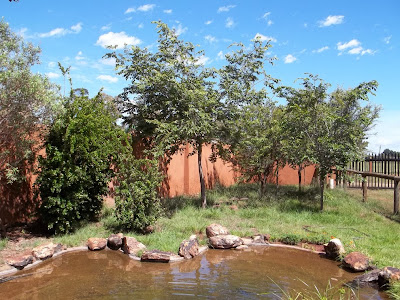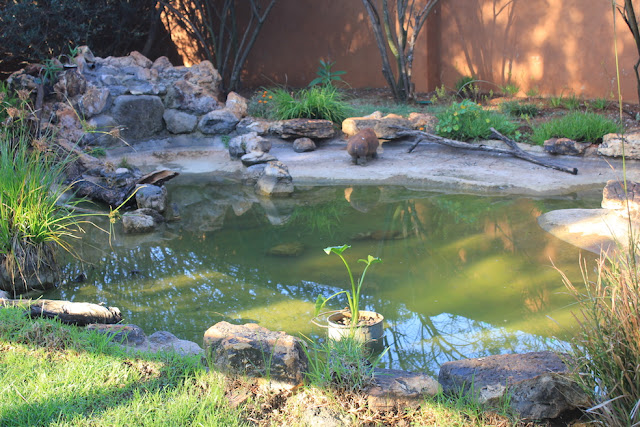Masked Weaver (Ploceus velatus) building his nest.
Camera : Canon EOS 550D
.
We’ve all met different kinds of gardeners. There are ornamental gardeners who aspire to have a garden worthy of showcasing in the pages of gardening magazines. There are vegetable gardeners who proudly feed their families (and neighbourhood) with the bounty of their land. And there are passionate wildlife gardeners who find great joy from a new bird or butterfly who has chosen to visit their wildlife garden.
I am a wildlife gardener. Personally, the entire reason that I garden is to create habitats for wildlife, and every choice that I make in my garden is made with the needs of wildlife as a top priority. What is beautiful to me is not the individual “specimens” of plants scattered through a garden, but the birds, butterflies, bees, insects, lizards, frogs and toads, and other wildlife who make their home in a garden that I have created. And happily, my garden will never appear in the pages of
Garden & Home!
.
2006 - Young Acacia's and Celtis's at my wildlife pond
.
2006 - Young Acacia's and Celtis's at my wildlife pond
.
2009 - Young Acacia's and Celtis's at my wildlife pond
.
By 2011 the Acacia's, Celtis's and Karee's were fairly well-established at my pond
.
2011 - starting to take shape
.
The White Karee's in my garden when planted in 2005
.
The Acacia karroo (Vachellia karoo) and Karee's in 2009
.
Planting mostly indigenous has really paid off. When my Celtis's, Acacias and Karee's were small, most of the birds, besides Sparrows and Weavers, were only occasional visitors to my garden. Since the trees and shrubs have become 'grown-up', an amazing array of birds have moved in, living and nesting here.
Black-eyed Bulbuls, Olive Thrush, Ground-scraper Thrush, Robins, Mynah, Black-throated Canary, Fiscal Shrike, Crested Barbet, White-browed Sparrows, Red-headed Finches, Red Bishop, Golden Bishop, Bronze Mannekins, Greater-striped Swallows, Rock Pigeons, Laughing Doves, Ring-neck Doves and
White-eyes.
Daily visitors (don't know where they live!) are the
Black Sunbird, Black-headed Oriole, Bokmakierie, Diederick's Cuckoo, Wood Hoopoe, Redbilled Woodhoopoe, Fork-tailed Drongo, Redwinged Starling, Glossy Starling, Arrow-marked Babbler, Grey-headed Bush Shrike, Mousebirds, Red-faced Mousebird, Red-chested Cuckoo (Piet-my-Vrou), Cape Turtle Doves and the occasional
Paradise Flycatcher, Grey Lourie and Pin-tailed Wydah. I've even had a couple of
King Fishers, although goodness knows why, I don't keep any fish.
.
Black-headed Oriole (Oriolus larvatus) at one of my feed tables
.
Ground-scraper Thrush (Psophocichla litsitsirupa) keeping an eye on me as I walk through the garden. they just love scratching through the loose leaf litter
.
Laughing Dove (Spilopelia senegalensis) fledgling - these little birds are SO trusting and unafraid...
.

Masked Weaver (Ploceus velatus) contemplating a nesting site in one of the Acacia's (Vachellia karoo)
.
Red-faced Mousebird (Urocolius indicus) - they are daily visitors now and I still don't know what attracts them as I never see them at the fruit tables
.
Grey Lourie (Corythaixoides concolor) visiting
.
A Glossy Starling (Lamprotornis nitens) making use of the bathing facilities
.
.
Indigenous planting has many benefits. Besides drawing birds, wildlife and insects endemic to your area, there is less chance of losing any plants due to extreme heat or cold. Planting indigenous species provides a living environment that is part of the local natural system. Indigenous plants have evolved as part of the entire biological population of an area. A strong interdependence exists between indigenous plants, animals, insects, and micro-organisms. Planting indigenous species can contribute to the maintenance of a balanced and diverse eco-system.
.
.
With habitat disappearing at an alarming rate, you can help provide wildlife with an oasis of the habitat they need to thrive. The native plants that you use can meet the needs, including food and cover, of native wildlife without causing long-term damage to local plant communities. With the right diversity of native plants in your urban landscape, you can provide:
.
• Protective cover for many animals.
• Seeds, nuts, and fruits for monkeys and other mammals.
• Seeds, fruits, and insects for birds.
• Nectar for Sunbirds and butterflies.
• Larval host plants for butterfly caterpillars.
.
Caterpillars (larvae) of the Speckled emperor Moth
.
Caterpillars (larvae) of the Speckled emperor Moth at the base of an Acacia karroo
.
The adult Speckled Emperor Moth after hatching sitting on a Restios
.
However, one of the most important advantages of planting indigenous is saving water – you also save yourself money and contribute towards overcoming the world's critical shortage of water.
.
The beautiful pom-pom flowers of the Indigenous Acacia karroo (Vachellia karoo)
.
Not only are indigenous plants water-savers and low maintenance but some also exude a wonderful perfume. A fragranced garden appeals to one of most evocative senses and with careful planning one can have a perfumed garden throughout the year. Use scented bulbs like freesias, scented agapanthus, night-scented gladioli, the wild honeysuckle tree, sweet salvias, jasmine and the lemon-scented pelargonium. Then there are those plants which release a strong aroma when touched. Pelargoniums (Geraniums) are best known for this. Favourites are the rose, nutmeg and peppermint scented.
.
Indigenous plants can be used to create impenetrable barriers and block out sound, making your garden a haven of security and tranquility.
.
Kei Apple
.
Kei Apple - ideal as a hedge due to its density
.
The virtually impenetrable thorns of the Kei Apple
.
An old favourite is the Kei apple, which can be trained very easily into a hedge plant. The lemon thorn is also an attractive intruder deterrent. Other types include the forest num-num, buffalo thorn, the common turkey berry, spiny gardenia, false forest spike thorn and prickly asparagus thorns.
Indigenous plants also make very effective windbreaks. It is a good idea to leave hedges in coastal gardens untrimmed and a bit wild so they act as wind breaks.
.
The garden in 2012 with the trees now well-established
.
Plant shrubs closer together so they can protect each other. The tick berry is ideal with its yellow, daisy flowered bush. It is quick growing and loved by birds for the fruits and by butterflies as a larval host plant. Try Honeysuckle and Plumbago (forget-me-not), both of which can be trimmed or left to scramble.
.
Bulbinella flower - attracts many insects and the leaves are useful for treating cuts and burns
.
Celtis africana (White Stinkwood) and the White Karee (Rhus viminalis, below) providing shade, shelter and food to many species of insects and wildlife
.
Weaver's nest in one of the White Karee's (Rhus viminalis)
.
Nest of the House Sparrow in one of the Acacia's taking advantage of the safety of the thorns- they will use the same nest year after year, just adding fresh leaves, as can be seen here. These little brown jobbies are renowned for their messy-looking nests!
.
So, if you would love to have lots of wildlife in your garden, then going indigenous is for you. I'm not saying that, if you are into neat borders, lots of colour and exotic plants and you hate leaves littering your lawn or garden beds, you won't have lots of wildlife in your garden - animals and insects are amazingly adaptive and resilient and make the most of whatever is on offer. The most important point is just that we carry on gardening and provide refuge and food for all the little creatures we share this planet with.
PS: Please excuse all the dots between paragraphs, but Blogger has been playing up lately and won't make paragraphs. In fact, Blogger seems to be totally out of sync, not quite the same since Google+ is taking over the world!
.
.













2605cropped.jpg)




































